Uncertain Hope Blooms for Tasmanian Devils
Posted on Categories Discover Magazine
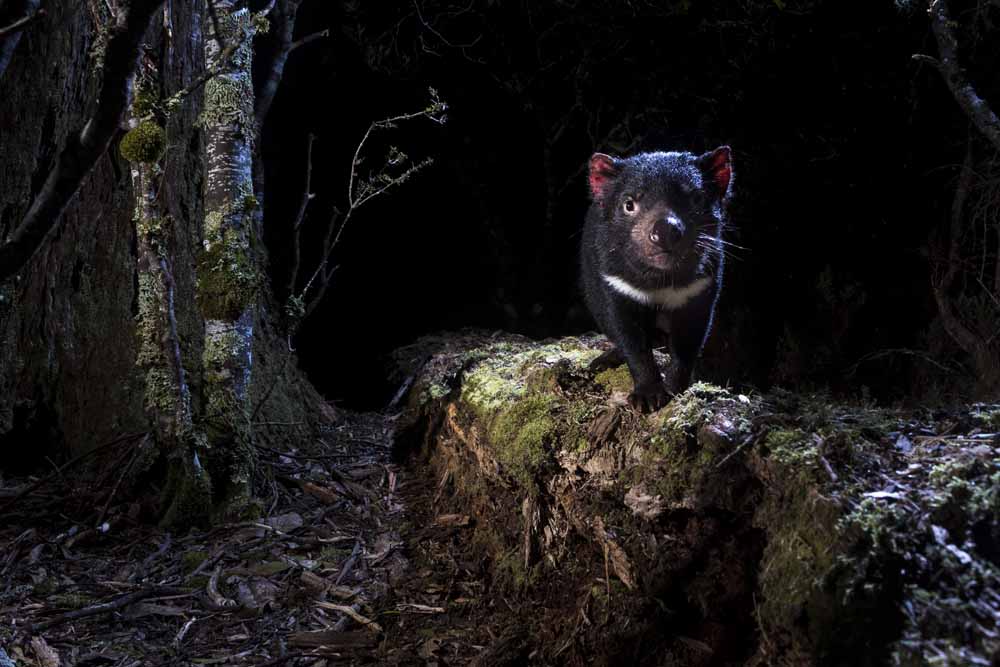
Using remote camera traps, photographer Heath Holden captured rare images like this one of wild Tasmanian devils (Sarcophilus harrisii) in their natural habitat. The animals’ bright red ears and eerie, raucous scuffles earned the scrappy marsupials their haunting common name. (Credit: Heath Holden)
On a misty summer morning in 2015, Manuel Ruiz ditched his pickup truck along a dusty two-track road in northwest Tasmania and trod into a grove of eucalyptus. He was searching for a devil. “If I were a devil, this would be a nice place to spend the night,” thought Ruiz, a wildlife veterinarian and doctoral candidate at the University of Tasmania.
The Tasmanian devil (Sarcophilus harrisii) is the world’s largest carnivorous marsupial. Despite that distinction, the animal is only about the size of a raccoon. But what the species lacks in heft, it makes up for with tenacity. At night, devils hunt and scavenge wallabies, possums, and other small mammals under the cover of their black fur. During the day, they retreat to underground dens and sleep off the rigors of their nighttime exploits.
As picturesque and wild as northwest Tasmania’s landscape may be, it is also a battleground for disease, and in 2015, Ruiz was patrolling the epidemic front lines. It didn’t take him long to find evidence of the fight. A few dozen paces into the undergrowth, he knelt to inspect a white cylindrical trap nestled amidst a lush cluster of ferns. Inside, a female devil peered down her pointed, whiskered snout at Ruiz. He had seen this individual, nicknamed Leesa, once before. A raw, oozing tumor as large as a ping-pong ball gaped behind the right corner of her mouth—the mark of a debilitating cancer.
Leesa and thousands of other devils suffer from what’s known as devil facial tumor disease. The cancer was first detected in 1996 in eastern Tasmania. Since then, it has spread rapidly across the island state, causing an overall species decline of 80 percent, with localized declines of more than 90 percent. A decade ago, scientists predicted imminent extinction for the critically endangered species.
Since then, some wild devils have begun to show signs of resistance, offering new hope for the species’ survival. And while the quickly spreading cancer has wrought great devastation, it has also offered scientists a rare window into the progression of cancer at large. Researchers are monitoring the disease as it runs its course, searching for clues that will help them derail it. They’re hopeful that their findings might soon be applied to combatting cancers in other species—maybe even in humans someday.
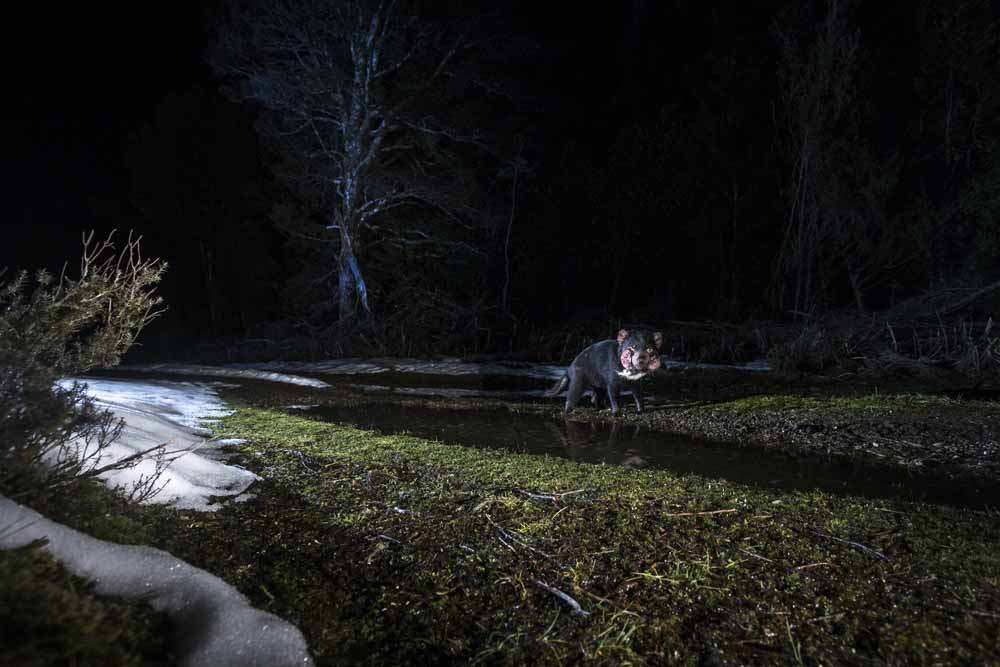
A Tasmanian devil with two large facial tumors walks along a fire trail at night. These tumors, caused by a form of cancer, can grow so large that they ultimately prevent the animal from feeding. (Credit: Heath Holden)
no matter what species it’s in,” says Greg Woods, an immunologist who recently retired from the Menzies Institute for Medical Research at the University of Tasmania after two decades studying the devils. Genetic mutations trigger runaway tissue growth, which leads to detectable tumors in most forms of cancer. “It’s the same mechanism,” says Woods, “just in the devils’ case it’s transmissible.”
Most cancers arise within their hosts and die along with them. But some are infectious, shuttled by agents like viruses (as in California sea lions), bacteria, or other microscopic vehicles. In devil facial tumor disease, the cancer cells themselves are the infectious agents—making the tumors transmissible from one individual to another. Transmissible cancers are not well understood, partly because they only recently landed on researchers’ radar screens. Of the eight known transmissible cancers identified so far in devils, dogs, and marine invertebrates, seven were detected within the past three decades.
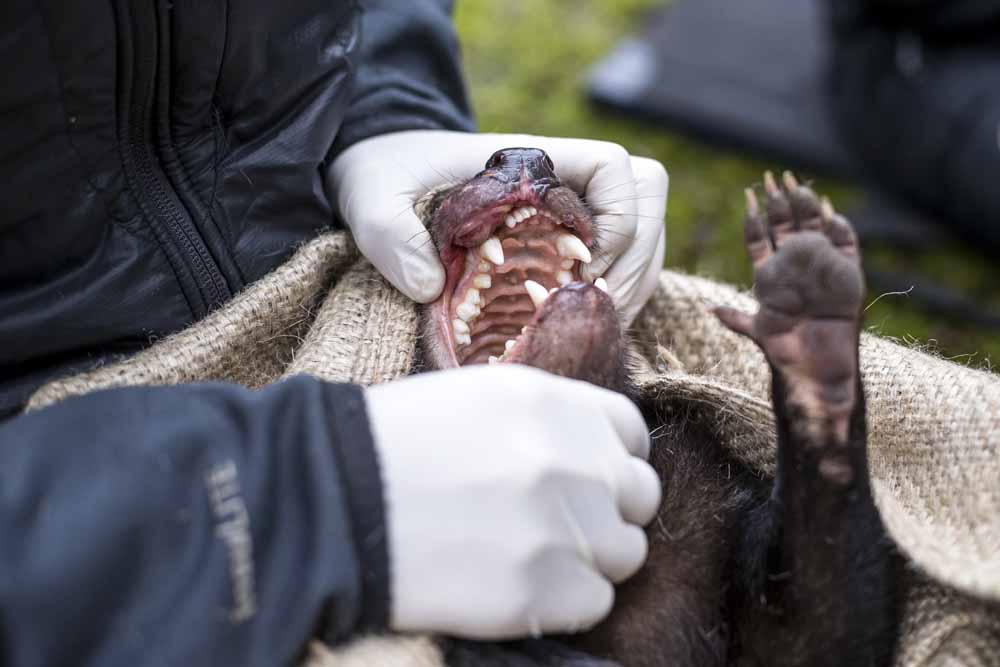
A devil is captured with a visible DFTD (Devil Facial Tumour Disease) near the upper canine and is checked out and a biopsy is taken for further study. (Credit: Heath Holden)
Devil facial tumor disease is passed from devil to devil through physical contact. Individuals brawl, bite, and scratch one another in competition for food and throughout the breeding season. (Early European settlers likened the haunting hisses and growls of their scuffles to the sounds of the Devil, and the name stuck.) During these clashes, an infected individual can transfer live tumor cells from its open wounds to a healthy devil’s face. The cells then grow into disfiguring, puffy blights that bloom in and around the animal’s mouth, face, and neck. Once contracted, the cancer is almost always the kiss of death.
Tumors may take down their host in a number of ways: by acquiring deadly bacterial infections; by growing so large they physically prevent the devil from feeding; or by metastasizing to other systems in the body and eventually causing organ failure. Once facial tumors appear, the cancer typically kills its host within six months to a year.
Scientists from government agencies and research institutions across Tasmania are tracking how devil populations fare in the wake of the cancer’s swift spread. Monitoring teams routinely visit sites across the island, staggering their data collection geographically to complement one another. Ruiz, who is a member of the University of Tasmania team, tracks the devil’s physiological response at several sites stricken by cancer in the northwest region. Out in the field, he and his colleagues snap mugshots of all individual devils they capture, which, when viewed as a collection, are reminiscent of a Most Wanted poster. Along with tissue samples, these photos allow the team to assess tumor growth over time.
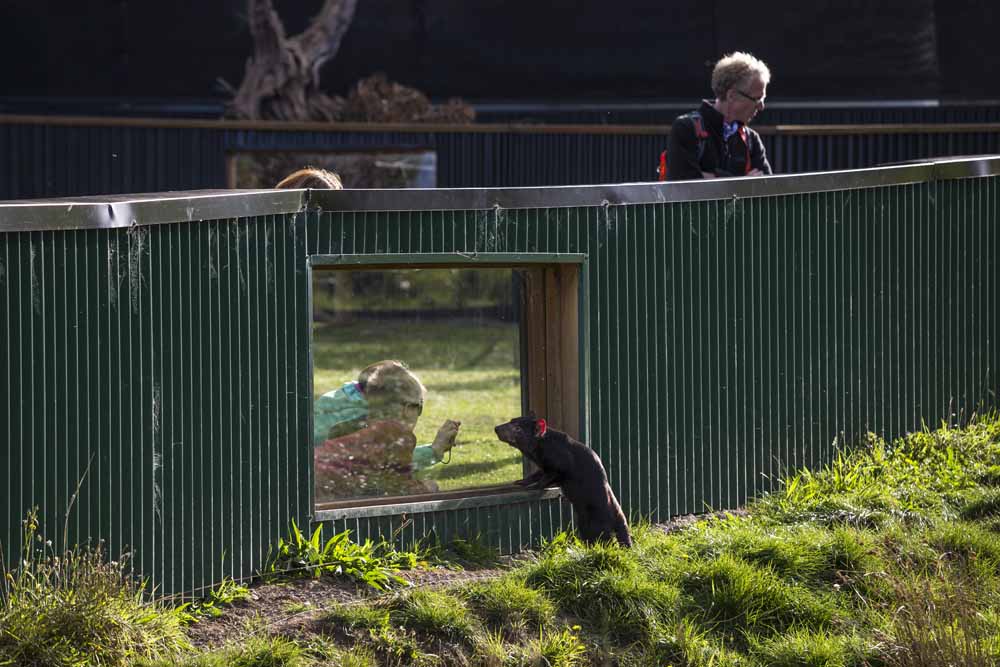
Visitors observea captiveTasmanian devilat Trowunna Wildlife Sanctuary, one of the first facilities to successfully breed devils in captivity and now a recognized authority on devil husbandry. (Credit: Heath Holden)
The scientists also analyze blood samples to chart the devils’ immune response as the cancer progresses. “We can be collecting blood samples, and the devils are just snoring away without a care in the world,” says Ruiz, who has trapped, micro-chipped, and tracked more than 400 devils. “They seem like a little teddy bear when they’re asleep—but with big jaws that can chop your finger off at any time.”
Even perfectly healthy devils are short-lived: Most individuals live just six years. Since the cancer’s outbreak two decades ago, several generations of devils have come and gone, and that short generation time may confer a selective advantage. People often think of evolution as happening over thousands or millions of years, but, according to Ruiz, it’s happening right now in Tasmanian devils and their cancer. “This is one of the most interesting systems in the world for understanding the evolution of pathogens and their hosts,” Ruiz says.
Once it emerged, devil facial tumor disease moved swiftly. Its progression through Tasmania was so alarming that the government launched the multi-stakeholder Save the Tasmanian Devil Program a mere seven years later. As an insurance measure, the program established a disease-free population of devils on an island off the Tasmanian coast. Nearly two-dozen zoos and wildlife parks across mainland Australia and Tasmania also pitched in to help maintain genetic diversity in captive populations. By 2013, the program had raised more than 500 captive, healthy devils. But officials were reluctant to re-introduce these individuals into the wild; odds were too high that the animals would contract the cancer and die.
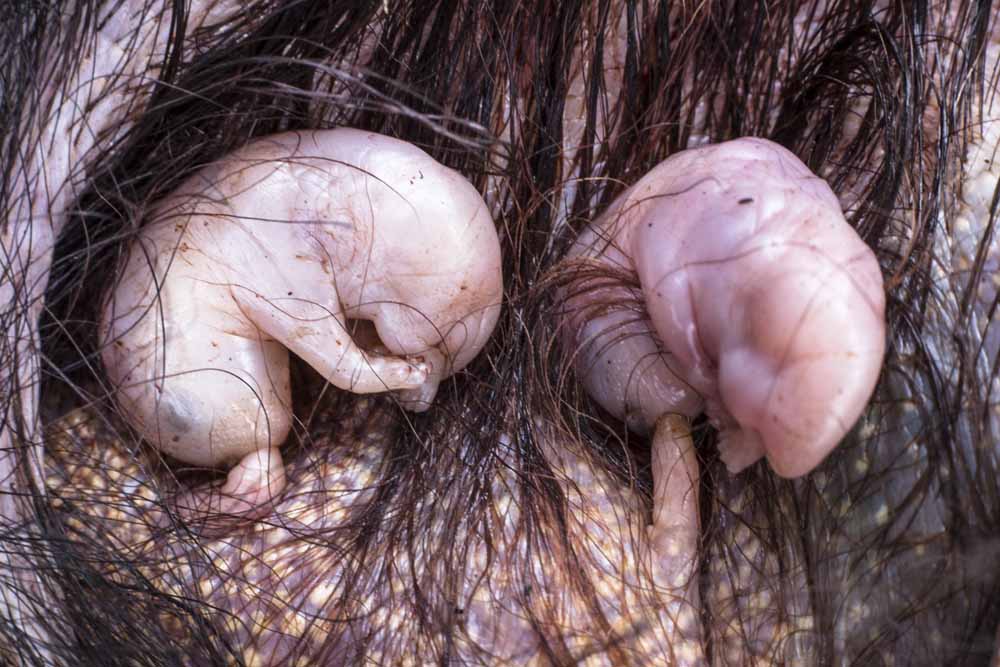
An expectant mother will lay down a trail of saliva for newborn pups to follow as they wriggle from the birth canal to her pouch. There they find warmth, protection, and nourishment. (Credit: Heath Holden)
That same year, scientists discovered that devil facial tumor disease had the capacity to hide markers on its cell surfaces. These molecules are what typically signal to the immune system that an intruder is present. With this discovery in mind, a team led by Woods at the Menzies Institute set out to develop a vaccine that could direct the devil’s immune system to recognize and target the cancer cells despite the inherent absence of more obvious signals. They first treated dead cancer cells with cytokines, special molecules that force the disease cells to express their surface markers. This makes the cancer recognizable to the body’s immune defenses. The team then injected these modified cancer cells into healthy devils. By delivering two types of immune-activating molecules known as antigens and adjuvants at the same time, the devils’ immune systems sprang into action—flagging the injected cells and producing antibodies to fight back. “We’re fighting cancer with cancer,” says Woods.
The scientific community was buoyed by the promise of this finding. But the trials had their limitations. Sample sizes were small, and vaccinated individuals released into the wild were sometimes difficult to catch again, making it a challenge to measure the vaccine’s effectiveness. Additionally, most of the animals that were eventually recaptured came back with malignant growths, indicating that while the vaccine could stimulate the immune system to produce tumor-fighting antibodies, it wasn’t protecting the devils from contracting cancer in the wild.
A year later, just as vaccine research was gaining momentum, researchers detected a new transmissible facial cancer in devils—a genetically distinct cell line that also causes tumorous boils across the face. So far, scientists have diagnosed only about a dozen devils with the new cancer. But they already know that it’s possible for an individual to contract both types simultaneously.
“There’s something that might make devils more susceptible to disease,” says Rodrigo Hamede, a research fellow at the University of Tasmania, and one of Ruiz’s advisors, who studies the ecology of transmissible cancer. According to Hamede, the emergence of a second transmissible cancer in the same species is rare and raises many questions about the perfect storm of factors that has targeted devils twice in just 20 years. He hopes to identify what makes devils susceptible; his findings may shed light on whether we could see a transmissible cancer emerge in humans someday.
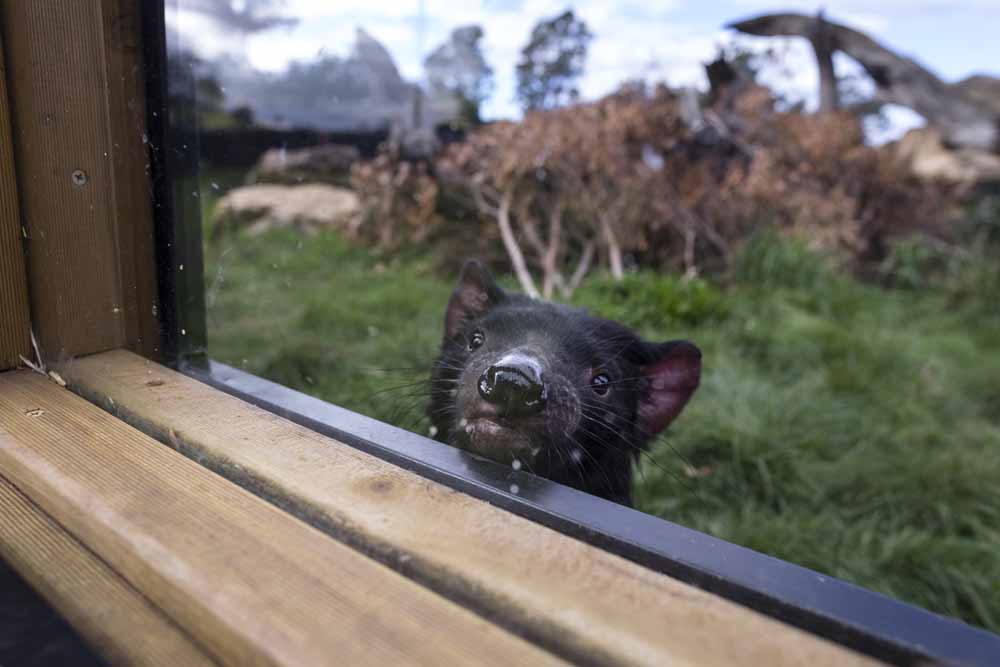
A curious Tasmanian devil peeks through a window at Trowunna Wildlife Sanctuary.In the wild, devils roam highly diverse habitats, from sandy beaches to lush rainforests and the high alpine. (Credit: Heath Holden)
When Ruiz first trapped Leesa in the summer of 2015, four of her teats were engorged, a sign that she had nursing pups awaiting her return to the den. Despite the gaping wound on her face, she was docile and calm when he interacted with her, which is typical of wild devils. (Captive devils often show more aggression toward humans.) When Leesa showed up in one of his traps a third time, five months later, Ruiz was happy to see that she had survived the disease long enough to raise and wean her pups. And to his delight, her tumor had taken an unexpected turn.
Once raw and red, the lump on her right cheek now gleamed with healthy tissue. Ruiz thumbed through Leesa’s previous datasheets in excitement to confirm before phoning Hamede from the field: Leesa’s tumor had naturally regressed. Somehow, she had developed antibodies to fight the disease.
Leesa was not the first wild devil to show spontaneous tumor regression. The University of Tasmania team had detected six other individuals with naturally regressing tumors before Leesa’s case was documented. Since then, eight more animals—a total of 15 devils at northwest monitoring sites—have shown signs of regression. And other individuals are simply living longer with their tumors; although transmission rates have remained high in northwest Tasmania, mortality rates and the overall devil population in the region have stabilized.
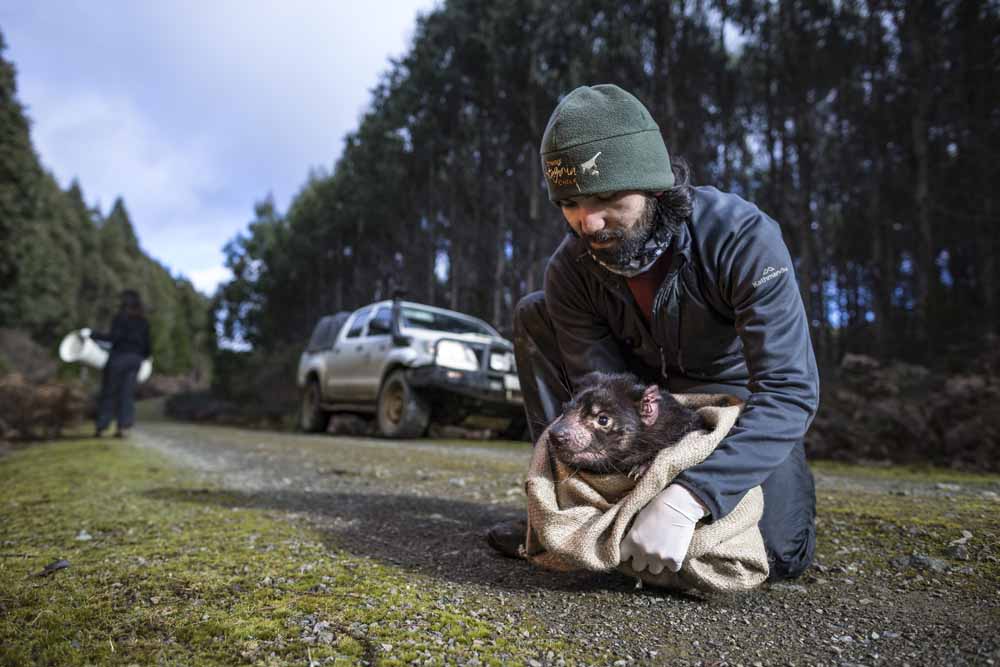
Adult female devil, Leesa is released from the scientist, Manuel Ruiz’s mesh bag after her checkup. Leesa is one of very few devils who has been recored to have tumour regression in the wild. (Credit: Heath Holden)
Armed with this information, scientists have been working to understand why some individuals are responding differently to the disease. Two years ago, a team that included Hamede looked at whether the species could be evolving natural mechanisms to combat devil facial tumor disease. They compared individuals from three sites across Tasmania, all born four to six generations after the cancer’s outbreak, and detected rapid changes in their genomes; two regions of genetic code in particular looked different. These regions contain genes that are known to influence cancer risk and immune function in humans—suggesting that devils could be evolving resistance. If scientists can firmly establish that certain devils have evolved resistance to the cancer, they may be able to accelerate the recovery of the species by introducing immune individuals into populations that currently lack genes for resistance.
Devils aren’t the only species benefitting from this research. Hamede hopes that what we learn from devils will inform immunotherapy—harnessing the body’s immune system to combat cancer—when treating other cancers, even those in humans. He and his colleagues are investigating differences in immune profiles in wild devils and the role they might have in the animals’ ability to resist tumors. By analyzing facial tumor disease and human cancer side by side, scientists can learn more about the fundamental role the immune system plays in combatting disease. “We have a more holistic view of cancer now that we wouldn’t have had without devils,” says Hamede.
Meanwhile, Woods’s team continues working to develop a vaccine that can prevent devils from contracting facial tumor disease. In the most recent trials, the team vaccinated more than 50 disease-free individuals from insurance populations and released them into the wild. Some animals were fitted with GPS collars to allow for higher recapture success and follow-up immunizations. The study found that 95 percent of vaccinated individuals produced antibodies that combat the disease.
The next step is seeing whether the vaccine can be strengthened in a way that would lead to tumor regression and keep devils from contracting facial tumor disease in the first place. The team remains optimistic that in the not-too-distant future, captive devils destined for the wild might be released with full immunity to the disease. These introductions will bolster wild populations that are still hanging on, despite the dire predictions issued a decade ago.
Ruiz last trapped and released Leesa in August of 2016, when she was an elderly 7 years old. While he assumes she no longer patrols the eucalyptus forests of northwest Tasmania, he feels strongly that Leesa likely died of old age or another natural cause—not from cancer.